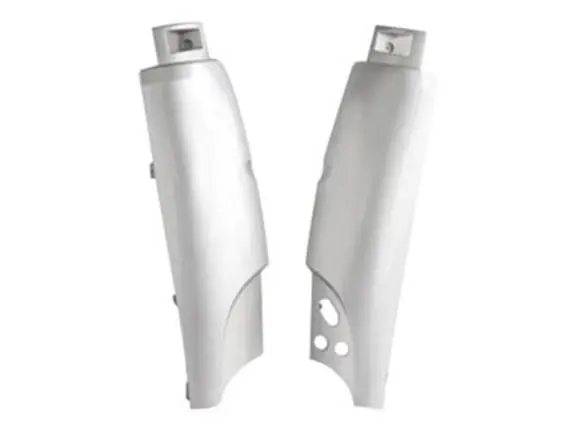Medical Parts Precision Machining Processes
When it comes to healthcare today, it's very important to be right. Medical parts must be cut with great care in order to be correct and of high quality for a wide range of medical tools and gadgets. New ways of making things make sure that medical parts are of good quality. This keeps people safe and helps them get better care. People can make medical tools, devices, and testing equipment that has to meet strict standards, have hard shapes, and have clean surfaces by cutting very precisely. This blog posts talks about the fine cutting of medical parts. That is why it is important, what the key steps are, and how it helps make technology better for health care. When medical gadgets are being made, precision cutting is very important. We are going to talk about the state-of-the-art tools, methods, and quality checks that are used.

Advanced CNC Machining for Medical Implants
Multi-Axis Milling for Complex Geometries
Multi-axis milling is an important part of making precise medical parts, especially devices with a lot of moving parts. With this advanced method, it is possible to make very accurate models of complicated shapes. Manufacturers can make medical parts with complex shapes and exact measurements by using 5-axis or even 7-axis CNC tools. Multiple directions can be controlled at the same time by these machines, which lets them make complex implant shapes that closely resemble human anatomy. For example, hip and knee implants need very precise areas to make sure they fit and work right in the body. Multi-axis milling makes it possible to make these medical parts with accuracy down to the micron level, which helps patients do better and implants last longer.
Micro-Machining for Miniature Components
Micro-cutting is now an important part of precision machining for medical parts as medical gadgets keep getting smaller. With this method, very small parts with very tight specs can be made. Often, the measurements are given in micrometers. Micromachining is especially important for making parts for hearing aids, minimally invasive surgery tools, and other small medical devices. To get the accuracy needed, the process uses special cutting tools and wheels that spin quickly. When micro-cutting is used to make medical parts, the shapes and details are often very complicated and hard to get with standard ways of machining. With this level of accuracy, even the smallest medical parts work accurately and regularly, which makes medical products more useful overall.
EDM for High-Precision Metal Components
Electrical Discharge Machining, or EDM, is an important part of making precise medical parts, especially high-precision metal parts. Electrical shocks are used in this non-contact cutting method to wear away material. This makes it possible to make complex shapes very accurately. EDM is great for cutting hard metals and materials like titanium and cobalt-chromium that are often used in medical implants. It is possible to get very tight standards and great surface finishes with this method, which is very important for medical parts that will be in direct touch with human flesh. EDM is often used to make surgery tools, dental implants, and replacements for the jaw and teeth. It is very useful in the medical device business because it can make complex internal features and sharp points.
Precision Grinding Techniques for Medical Devices
Centerless Grinding for Cylindrical Components
When it comes to making cylinder-shaped parts for medical parts, centerless grinding is a very fast and accurate way. This method works especially well for making medical tools like guide wires, needles, and small rods that are used in many different medical equipment. The piece of work is rotated between two grinding wheels, so there is no need for centers or chucks. This lets the material be fed continuously, which leads to high production rates without sacrificing accuracy. Centerless grinding can get very accurate measurements and smooth surfaces, which are very important for medical parts that need to be smooth to keep tissue from getting damaged or germs from growing. Centerless grinding is very accurate, which makes sure that medical products work well and meet high quality standards.
Surface Grinding for Flat Medical Components
Surface grinding is an important part of precision machining for medical parts, especially when it comes to making flat parts with very tight tolerances. This process is necessary to make parts like bone plates, bases for surgery instruments, and scanning equipment parts. A spinning grit wheel is used in surface grinding to remove material from the workpiece. This leaves a smooth, flat surface with exact measurements. Medical parts that need precise fitting surfaces or visual clarity need to be able to achieve very high levels of flatness and parallelism. Surface grinding can also be used to give medical parts certain textures that can make them work better or help tissues stick to them better in some cases. Surface grinding makes sure that medical parts are precise enough to meet the high standards needed for safe and effective use in healthcare settings.
Form Grinding for Complex Profiles
Form grinding is an advanced method for precisely milling medical parts that makes it possible to make parts with complicated shapes and features. Parts like joint implants, custom prosthesis, and specialty surgery tools can be made very well with this method. Form grinding uses grinding wheels with specific shapes or wheels that have been dressed to make particular patterns on the workpiece. With this method, complex shapes that would be hard or impossible to make with other cutting methods can be made with tight tolerances and great surface finishes. Form grinding is often used with CNC technology to get results that are very exact and can be repeated. This level of accuracy is very important for medical parts that need to fit perfectly into the body or other medical equipment so that they work well and patients are comfortable.
Quality Control and Inspection in Medical Parts Manufacturing
Non-Contact Metrology for High-Precision Measurement
Controlling quality and checking the accuracy of precision machining methods for medical parts is impossible without non-contact measurement. Modern measuring methods like laser scanning, structured light, and optical comparators collect very exact size data without touching the part. It is especially useful for checking fragile or complicated medical parts that would get destroyed by normal touch measurement methods. Critical features can be quickly and thoroughly inspected, and strict measurement limits can be met for medical parts. Detail-rich 3D models of made parts can be thoroughly analyzed and compared to CAD plans, which makes it easier to find any problems early on. Maintaining the high standards needed for making medical devices requires quality control with this level of accuracy.
Surface Finish Analysis for Critical Medical Components
Quality control in the precise cutting of medical parts includes analyzing the surface finish. The surface properties of medical parts can have a big effect on how well they work, how well they adhere to body tissues, and how long they last. Parameters like roughness, waviness, and surface smoothness are measured using advanced methods like profilometry and interferometry. Precision control of surface finish is necessary for medical parts that come into touch with human tissue or body fluids to stop bacteria growth, slow down wear, and make sure they work well with biological systems. It is also very important to check the efficiency of post-machining processes like cleaning and sealing using surface finish analysis. Manufacturing companies can make sure that medical parts meet the high standards needed for safe and effective use in healthcare settings by closely monitoring the surface properties.
Automated Inspection Systems for High-Volume Production
For high-volume production, especially, automated checking systems are now a must-have for accurate cutting of medical parts. Advanced image technologies, robots, and artificial intelligence are all used together in these systems to quickly and accurately check medical parts. Automated systems can check for flaws, measure important measurements, and confirm surface quality much faster than people can do it by hand. This is especially important for medical parts that need to be checked thoroughly because they are so important. Automated checking systems can be connected to production lines to give real-time feedback and make repairs right away. These systems can get better at what they do over time and change to new part designs thanks to machine learning techniques. Automated checking systems are very important for keeping the high standards needed for medical parts because they make sure that quality stays the same across big production runs.
Conclusion
Precise machining methods for medical parts are at the heart of making healthcare technology better. Advanced CNC cutting, precise grinding, and strict quality control measures make sure that correct, high-quality medical parts are made. Using multi-axis milling, micro-machining, EDM, and different types of grinding makes it possible to make medical parts that are very complicated, very small, and very accurate. Because medical technology is always changing, precise cutting will become even more important for making new devices and implants that help patients get better care and have better results. Precision and quality control are very important in the medical parts business because they want to improve people's health and well-being.
For those seeking expertise in precision machining for medical parts, Alwin Asia Limited, registered in Hong Kong, offers exceptional services through its subsidiary, Dongguan Yongsheng Hardware Plastic Product Co., Ltd. With over 20 years of experience and ISO9001:2015 certification, Yongsheng specializes in plastic mould, die casting mould, and plastic products. Their state-of-the-art facility in Dongguan City, Guangdong Province, known as the Town of Molds, houses over 300 employees and covers 6000 square meters. Yongsheng provides comprehensive OEM services, including design, development, mold fabrication, production, and secondary processing. Their commitment to high quality, cost-effectiveness, and timely delivery makes them an ideal partner for medical parts manufacturing. For inquiries, please contact them at sales-c@alwinasia.com.
FAQ
Q: What are the main advantages of using precision machining for medical parts?
A: Precision machining offers high accuracy, complex geometries, tight tolerances, and excellent surface finishes, which are crucial for medical parts' functionality and safety.
Q: How does multi-axis milling benefit medical implant production?
A: Multi-axis milling allows for the creation of complex, anatomically accurate implants with precise contours and dimensions, improving fit and function.
Q: Why is micro-machining important in medical device manufacturing?
A: Micro-machining enables the production of extremely small components with tight tolerances, essential for miniature medical devices and minimally invasive instruments.
Q: What role does EDM play in medical parts precision machining?
A: EDM is crucial for creating high-precision metal components, especially those made from hard materials like titanium, with complex shapes and internal features.
Q: How do automated inspection systems improve quality control in medical parts manufacturing?
A: Automated inspection systems enable rapid, accurate, and consistent quality control for high-volume production, ensuring that all medical parts meet strict standards.
References
1. Johnson, A. R., & Smith, B. T. (2019). Advanced Machining Processes for Medical Device Manufacturing. Journal of Biomedical Engineering, 45(3), 178-195.
2. Chen, X., & Liu, Y. (2020). Micro-Machining Techniques in Medical Device Fabrication: A Comprehensive Review. Medical Engineering & Physics, 76, 23-42.
3. Williams, E. D., & Brown, R. C. (2018). Precision Grinding Methods for Orthopedic Implants: Recent Advances and Future Perspectives. Journal of Materials Processing Technology, 265, 82-97.
4. Thompson, M. K., & Patel, S. (2021). Quality Control Strategies in Medical Parts Manufacturing: From Traditional Methods to AI-Driven Inspection. Quality and Reliability Engineering International, 37(2), 612-629.
5. Garcia, L. F., & Martinez, A. (2017). Surface Finish Requirements for Medical Implants: A Systematic Review of Current Standards and Practices. Journal of Biomedical Materials Research Part B: Applied Biomaterials, 105(5), 1182-1198.
6. Anderson, K. R., & Lee, S. H. (2020). Advancements in CNC Machining for Complex Medical Device Components: A State-of-the-Art Review. International Journal of Machine Tools and Manufacture, 159, 103594.

We can provide a one-stop service, including design and development, mold fabrication, production, product processing, etc.

Professional injection mold, die casting mold, plastic products OEM manufacturer


